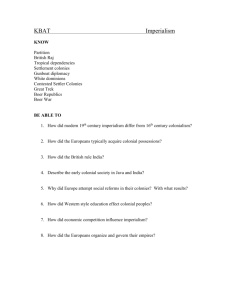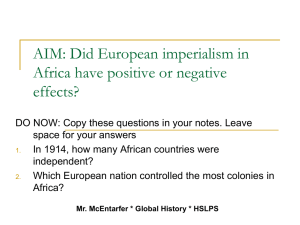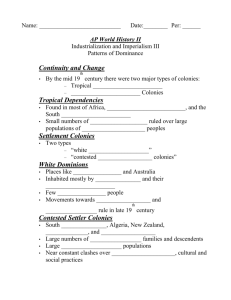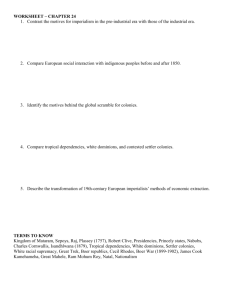1. - SchoolRack
advertisement
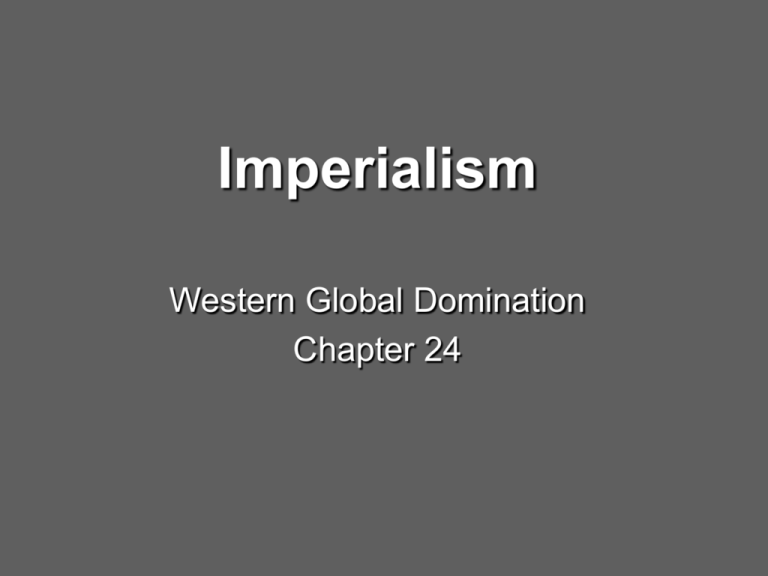
Imperialism Western Global Domination Chapter 24 Vocabulary 1. Sepoys 2. Raj 3. Plassey 4. Robert Clive 5. Presidencies 6. Nabobs 7. Charles Cornwallis 8. Tropical dependencies 9. White dominions 10. Settler colonies 11. Great Trek 12. Cecil Rhodes 13. Boer War (1899-1902) 14. James Cook 15. Nationalism Rise of Imperialism European Colonial Territories Before and After 1800 I. European Imperialism A. Major Factors 1. Nature of European overseas expansion changed by Industrial Revolution a. Initially driven by precious metals, plantation crops, and foreign goods b. Changed to raw materials needed for Industrialization, markets for manufactured products, spread of Christianity c. Expansion also fueled by European rivalries 2. Initial expansion confined to periphery except in the Americas…WHY? a. New technology in transportation and weaponry allowed Europeans to penetrate all areas of the globe Colonialism v. Imperialism Colonialism Imperialism 1500 - 1750 1750 - 1914 Establishment of colonies Establishment of colonies Goals: Gold & silver; plantation crops; foreign goods (spice); Christianity Goals: Raw materials; markets; Christianity Interaction: Periphery (except for the Americas) • Inability to travel upstream • Inability to overpower indigenous peoples • Susceptibility to disease Interaction: Penetration • Steamships • Weapons (machineguns) • Improvements in medicines Source for Raw Materials Industrial Revolution Markets for Finished Goods European Nationalism Missionary Activity European Motives For Colonization Military & Naval Bases Social Darwinism Places to Dump Unwanted/ Excess Popul. European Racism “White Man’s Burden” Humanitarian Reasons Soc. & Eco. Opportunities 3. Technological innovations a. Steamship – Fulton b. Telegraph – Morse c. Railroad – Stephenson d. Weapons 4. Education a. Some natives educated & staffed growing bureaucracies 5. Other Factors a. Increasing racism – decreased mixing b. More European families in colonies c. Growing numbers of missionaries d. White racial superiority – the White Man’s Burden Lawyer Gandhi in South Africa Looking at “The White Man’s Burden” • Which of the stanzas could best be summarized by…… • Part of the white man’s burden is to cure illness and bring peace to the savage lands you are conquering. Just be careful not to let the lazy ways of the savages undo all that you have worked for. Now look at • All of the stanzas again. Which could be summarized by saying…….. • We will be sending our most elite soldiers and people to help these savages. In a way they are not doing this for our country but we are actually working FOR the savages, doing what’s best for them. Ok… last one • Which stanza is summarized by…… • Don’t rush the good work that you do. It’s going to take time. Don’t be scared but also don’t try and take too much credit for what you do. Be basic. You have to put things in ways the savages will understand. Look now at just the 4th stanza • In your small groups, please try to summarize what you “think” this stanza is trying to say. Stanzas 5-7 • Now in your small groups, please do a summary for the final 3 stanzas. This will be your group’s ticket out of class. B. Industrial Rivalries & the Partition of the World 1. 1800’s – Western scramble for colonies a. Colonies seen as essential for status as a great power b. Colonies needed for raw materials & secure markets c. Colonies easier to secure due to technological advances d. Native peoples unable to resist in either open or guerrilla warfare What areas avoided Colonization? e. Religious leaders often headed struggles…ex: Boxers f. Most of the non-Western world colonized by 1914 C. Changes in Patterns of Colonization 1. Tropical dependencies…small numbers of whites ruling large native populations 2. White dominions…small amount of settlers / large territory 3. Contested settler colonies…clash between whites and indigenous peoples over land, resources, etc D. Shifts in Economic Extractions (1850) 1. New efforts to increase production in colonies 2. Some benefits to colonies through wages and/or cheap Building a railroad in the Belgian Congo European consumer goods 3. Colonial economies developed to meet needs of industrial Europe a. Raw materials went to Europe – profits went to Europe b. Laborers and colonies became economically dependent on Europe 4. Technological advances increased extraction of raw resources from colonies (infrastructure) Mining minerals in the Belgian Congo II. European Imperialism in Asia The Stages of Dutch Expansion in Java A. The Dutch Way (1600s) 1. Initially pay tribute 2. Taking part in political rivalries allowed the Dutch to gain land…they used military alliances to gain land…Dutch troops were primarily native a. By 1750, they dominate Java b. Introduction of European culture = increased racism B. The British in India Directors weren’t really interested in acquiring colonial territories!!! 1. British East India Company a. End of Mughal Empire helped the British gain control --Company officials intervened in native political disputes --Used Sepoys…Indian troops trained in European-style fighting b. Competition with French --1757, Victory at Plassey --Robert Clive defeats Bengal ruler giving the British control of the rich Bengal region A Sepoy soldier --Ineffective Indian resistance due to disunity 2. Britain Consolidates Power a. Mughal decline gives British opportunity b. Presidencies…administrative centers at Madras, Bombay, Calcutta…ruled the majority of British territory in India --Rest of India indirectly ruled through Indian princes The Growth of the British Empire in India, from the 1750s to 1858 3. Initial European Societies in Asia (Prior to 1850) a. Asian societies mostly left in place…Europeans become the dominant class --Europeans adopted local styles of dress, food, housing, work habits, and political symbols…was necessary to survive --European males marry indigenous women 4. British Government Takes Control…makes social changes a. Widespread corruption (by Nabobs) within the East India company led to a famine in Bengal…caused much stricter controls --British East India Company became much more accountable to the British government…local British rulers saw powers reduced --Reduced participation of Indians in government b. Evangelical religion movement grew --Christian-led cultural infusion of Western education (in English), institutions, values, and technology --Development of educated Indian middle class The custom of sati --Worked to end to slave trade --End to sati sought c. The British attempted to reshape colonial society in Western style III. The Battle for Colonies, 1870-1914 By the end of the 19th century, Europe A. European Power dominated the globe 1. Military might led to increased due to its military imperialism and industrial might. a. Mass-produced weapons, especially the machine gun made this possible. b. Railroads and steam ships made moving armies and raw materials much easier. The Partition of Southeast Asia and the Pacific, to 1914 The Partition of Africa between c. 1870 and 1914 IV. Continuity and Change within European Dominance A. “Tropical dependencies” 1. Africa, Asia (India, Indonesia, Indochina), South Pacific 2. Europeans rule indigenous peoples B. Settler colonies – Two types 1. “White Dominions”…inhabitants are mostly Europeans a. Canada --Western expansion at expense of native societies --Continuation of Western culture --Increasing self-determination b. Australia…began as a penal colony --Moved into interior against few aboriginal people --Growing autonomy --Gold rush increased immigration 2. Contested Settler Colonies…such as Algeria, Kenya, South Africa, New Zealand, Hawaii a. Large numbers of Europeans lived among even larger indigenous numbers --Increasing conflict over time…resources and cultural, social differences C. Colonial Leadership and Social Stratification in Dependencies 1. Cultural influence a. English language education supported by the state --Missionaries run schools 2. Changing Social Relations Within the Colonies a. European communities grow within the colonies…segregation began to increase dramatically --Ideas of white supremacy spread…Africans were at the bottom of the social hierarchy D. South Africa (Boers)…began as Dutch colony at Cape Town --After gradual move into the interior, Afrikaners enslaved the natives…led to a large “colored” population 1. British rule in South Africa a. Attempt to end slavery, but Afrikaners resist --Afrikaners move inland (Great Trek)…eventually this puts them into conflict with the Bantu (Zulus) --This caused instability in the region…forced the British to become more involved b. Afrikaners form independent republics in the 1850s --Discovery of diamonds and gold increased tensions between Afrikaners and British --Boer wars (1899-1902)…between the British and Afrikaners; British victory and postwar policies left the African population of South Africa under Afrikaner control --Cecil Rhodes --Beginnings of Apartheid Boer boy in British concentration camp The Boer War: 1899 - 1900 The Boers The British E. Pacific Tragedies 1. New Zealand…1790s…first Europeans were timber merchants and whalers a. Alcoholism, prostitution spread b. Maoris adopt firearms…take terrible toll in warfare…also suffer drastically from European diseases c. Changes come in the 1850s --Maori begin to convert to Christianity --Increased immigration in the form of British farmers and herders --Maoris pushed into interior as Europeans occupied the more fertile areas of land --Maoris adopt European culture to survive Maori Warrior Maori Tribesmen 2. Hawaii…Opened to the west by James Cook a. Prince Kamehameha – Accepts Westernization --By 1810, he rules a unified Hawaiian kingdom with British support…he increases trade with West b. US missionaries spread Christianity; bring changes in culture – especially education c. Disease decimate population – exploitation by the introduction of plantation crops d. Asian (Chinese & Japanese) workers and American settlers lead to major population shift e. American planters push for annexation…weak rulers pushed out…in 1893, last ruler deposed; in 1898, annexed by United States Sugar & Pineapple were most common European imperialism in Asia F. The Spanish-American War 1. Areas Involved a. Cuba b. Puerto Rico c. Philippines 2. Panama Canal 3. Economic imperialism Charge up San Juan Hill – Cuba 1898
